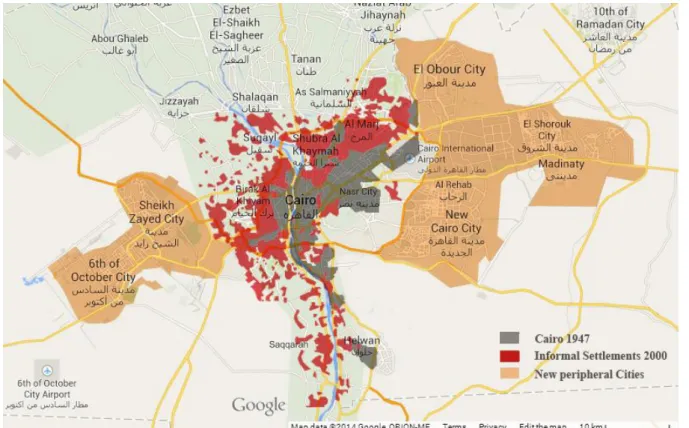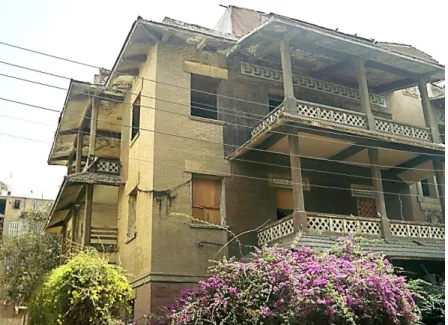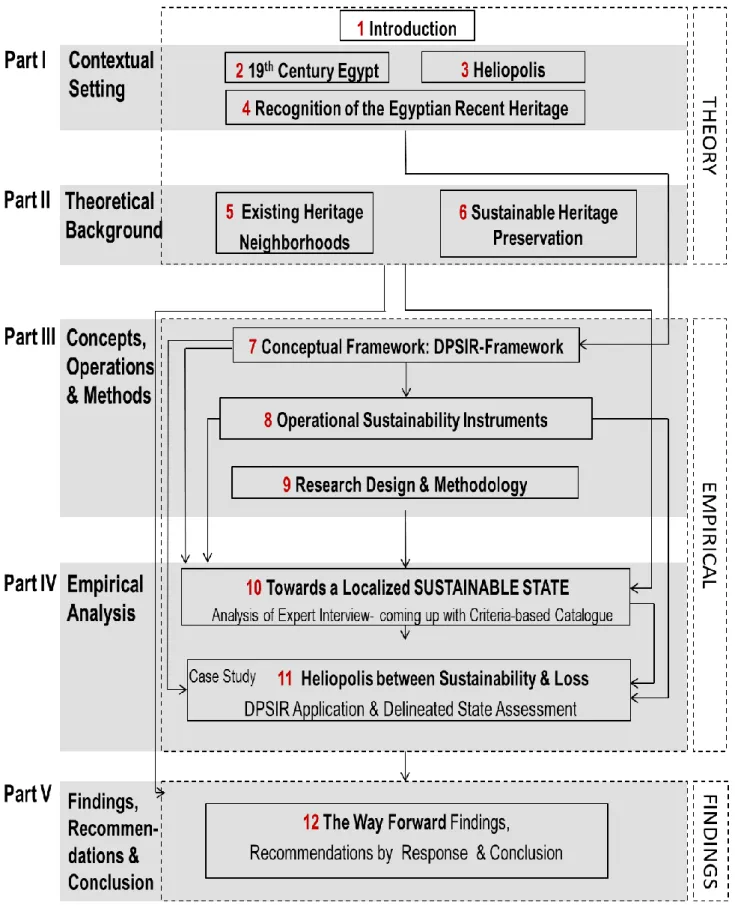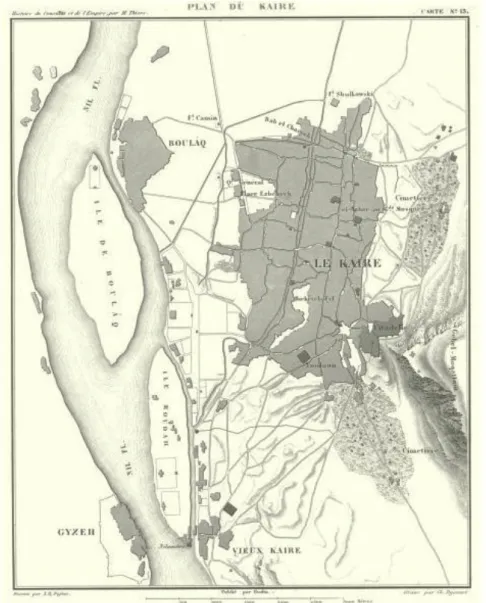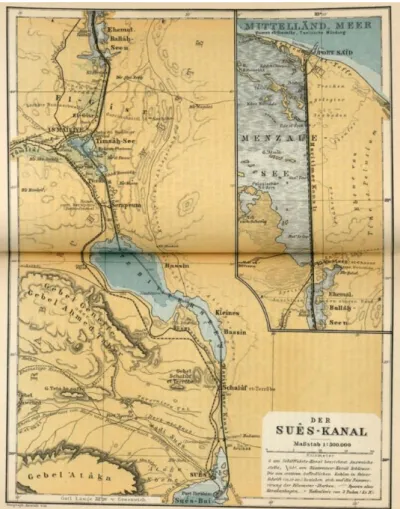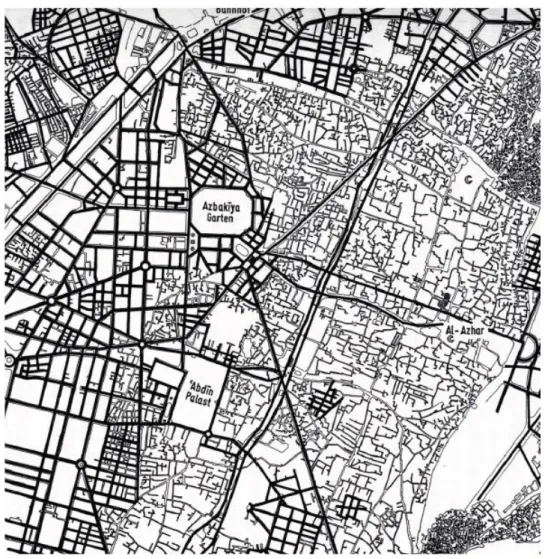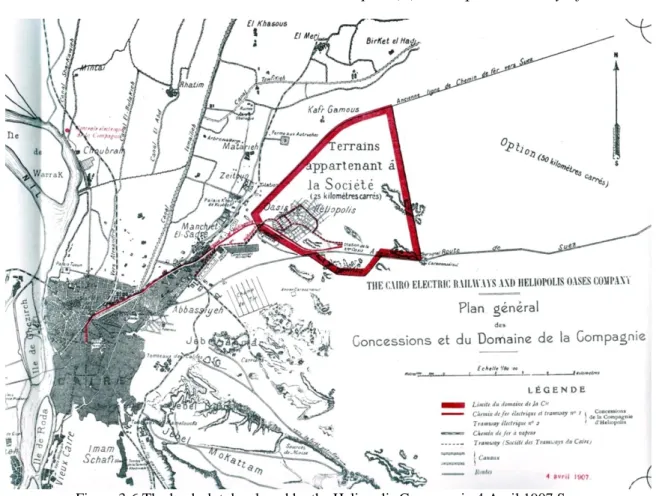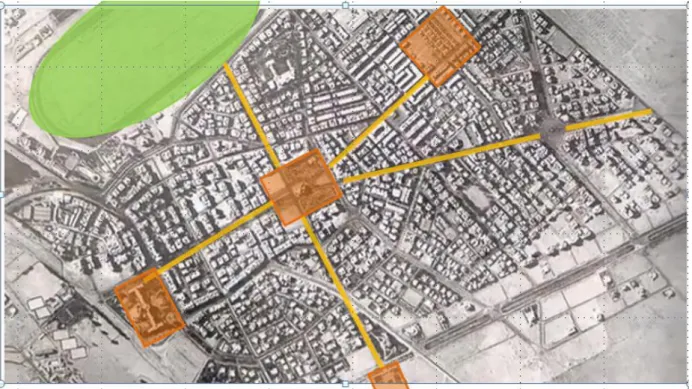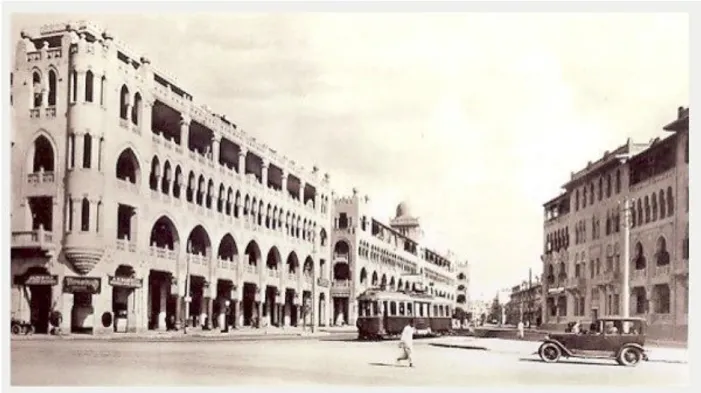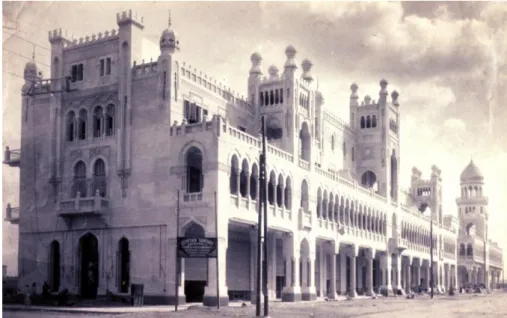Towards a Sustainable Preservation Approach To Egyptian Heritage Neighborhoods
The case of Heliopolis
Dissertation for the achievement of the Academic Grade Doctor of Engineering (Dr.-Ing.) at the Faculty of Spatial Planning, Technical University of Dortmund, Germany
Presented by:
Sara Moustafa Gouda M.Sc. in Urban Design
September, 2015
Towards a Sustainable Preservation Approach To Egyptian Heritage Neighborhoods
The case of Heliopolis
Dissertation for the achievement of the Academic Grade Doctor of Engineering (Dr.- Ing.) at the Faculty of Spatial Planning, Technical University of Dortmund, Germany
Presented by:
Sara Moustafa Gouda M.Sc. in Urban Design
Supervisors:
Univ. Prof’in Dip.-Ing. Christa Reicher Head of the Department of Urban Design and Land-use Planning at the Faculty of Spatial Planning at TU- Dortmund
Univ.Prof. Dip.-Ing. Architect Ulli Meisel
ILS Aachen, Honorary Professor in the Department and Institute of Housing and Design Basics at RWTH Aachen
Examiner:
Univ. Prof’in Dr. Soheir Zaki Hawas
Architecture & Urban Design Professor at the
Department of Architecture at the Faculty of
Engineering, Cairo University, Egypt
Zum Nachhaltigen Erhaltungs-Ansatz Ägyptischer Denkmalquartiere
Am Beispiel Heliopolis
Dissertation zur Erlangung des akademischen Grades Doctor-Ingenieur (Dr.-Ing.) an der Fakultät Raumplanung, Technische Universität Dortmund, Deutschland
Vorgelegt von:
Sara Moustafa Gouda M.Sc. in Urban Design
Gutachter/innen:
Univ. Prof’in Dip.-Ing. Christa Reicher
Leiterin des Fachgebiets Städtebau, Stadtgestaltung und Bauleitplanung
an der Fakultät Raumplanung der TU- Dortmund Univ.Prof. Dip.-Ing. Architekt Ulli Meisel
ILS Aachen, Honorarprofessor an der RWTH Aachen Lehrstuhl und Institut für Wohnbau und
Grundlagen des Entwerfens
Prüferin:
Submitted By:
Sara Gouda
Sara.gouda@tu-dortmund.de
Doctoral Committee:
Head of Committee &
Principle Supervisor: Univ.Prof’in Dip.-Ing. Christa Reicher Principle Supervisor: Univ.Prof. Dip.-Ing. Architect Ulli Meisel External Examiner: Univ. Prof’in Dr. Soheir Zaki Hawas
Disputation Date: 14. September, 2015
All rights, including the rights of reproduction, distribution and the translation
Dissertation, accepted by the Faculty of Spatial Planning, Urban Design, of the
Technical University Dortmund, Germany
DECLARATION OF AUTHORSHIP
I, Sara Gouda declare that this thesis and the work presented in it are my own and it has been generated by me as the result of my own original research. Where it is indebted to the work of others, acknowledgements have duly been made.
Sara Gouda,
Dortmund, September 14, 2015
ACKNOWLEDGMENT
At this point of finalizing my dissertation, I would like to thank all persons who supported and helped me until reaching this stage. This dissertation would not have been possible without the help of so many people. It was a result of a long journey that is still going on.
I hereby want to express my deepest appreciation and gratitude to my committee chair Prof’in Christa Reicher and Prof. Ulli Meisel for their continuous constructive follow up and regular fruitful discussions. I also owe a deep thanks to Prof. Dr. Soheir Zaki Hawas, from Egypt providing me ample time to discuss all needed issues.
I also want to thank my father (RIP) who taught us that the real investment is in learning, offering us the best education possible in order to grow-up as competitive unique personalities. All my gratitude goes to you my father, who would have certainly wished to see this day coming as much as I wish his presence today. My gratitude goes also to my beloved mother and my brothers and sisters for their encouragement, Hossam, Dalia, Dina and Mohamed.
Seven years ago I have shared my dreams of studying abroad with my fiancé at that time, Abdelhamid who believed in me and promised me support in every step I take. Seeing the dream coming true, no words are enough to express my gratitude to you and the kids, bearing all the hard time and stress throughout the previous years.
Special thanks go to Prof. Eckhardt Gerber who introduced me to Prof. Reicher, strongly recommending me to her and encouraging me to carry out my PhD at the TU-Dortmund. I also want to thank the small circle of PhD peers; you were very helpful Lars Nieman, Jan Polivka, Mais Jafari and above all Ahmed El-Atrash for your useful conversations and comments.
Last but not least, I want to thank all the people who provided me with information or Data useful for the study thanking Ahmed Mansour, Choukri Asmar and Michel Hanna of the Heliopolis Heritage Initiative (HHI) for sharing their dreams about Heliopolis.
Sara Gouda
Dortmund, September 14, 2015
In memory of my father may his soul RIP
AbdelHamid, Omar, Adam & Mom
my beloved ones
ABSTRACT
The Egyptian neighborhoods of the 19
thand early 20
thcentury are heritage neighborhoods that have introduced new urban patterns, planning concepts and architectural styles that have a unique character and value worth preservation. These neighborhoods are currently facing different types of encroachments that form a pressure (P) on their state (S) resulting into negative impacts (I) adversely affecting its various qualities. These impacts (I) stimulate responses (R) seeking solutions for a better state (S
1).
In the late 90’s in Egypt there was a political interest in 19
thand early 20
thcentury neighborhoods which resulted in carrying out several studies on these neighborhoods also called recent heritage. Ten case studies were chosen in Cairo including Heliopolis. The study on Heliopolis came up with recommendations mainly focusing on heritage and urban oriented guidelines yet missing economic, social and environmental considerations. These aspects should be by now put into account when dealing with recent heritage neighborhoods.
Sustainability as a broad concept encompasses these aspects. Adapting a sustainability approach for heritage neighborhood preservation, would enhance its performance by respecting the different qualities such as the urban, social, and economic ones beside the environmental and cultural.
The research at hand tries to fill the knowledge gap in the field of sustainability within existing neighborhoods through the reconciliation between both sustainability and preservation in a way that suits the Egyptian context. The conceptual framework of the research at hand adopts the DPSIR-framework developed by European Environmental Agency and extends it into a DPSIR
(1,2,3)-SS aiming to better identify the fragmented problem within the chosen case study of Heliopolis breaking it down into its different elements.
The aim of this research focuses mainly on three issues; 1) to define the sustainable state (SS) criteria within the recent heritage neighborhoods, 2) to determine the state (S) of the case study of Heliopolis, and 3) to investigate and recommend suitable responses (R) aiming to enhance the state of the neighborhood. In order to do so, the research carries out a mixed-method approach based on a single case study using qualitative and quantitative data.
In order to know the sustainable state (SS) qualities; a criteria-based catalogue was initially formed from existing literature, determining the important sustainability and preservation principles. This template forms the ground for a semi-structured expert interview based on a questionnaire which asks experts about the importance and the applicability of each criterion.
After analyzing the interviews the research will be able to come up with a preliminary sustainable state (SS) catalogue that will be partially tested on Heliopolis assessing its state (S). Furthermore, possible intervention measures and strategies are proposed for the three responses (R) HHI, NOUH and the governmental decision makers within Heliopolis. The extensive analysis of the respondents’ answers has shown that the proposed localized sustainable state catalogue could be a legitimate approach for recent heritage neighborhoods.
As a conclusion, this study has revealed that the HHI as a grassroots has a big role as a response (R) on protecting the heritage and spreading community awareness on the neighborhood scale. The NOUH is a nucleus for a much stronger entity that would be capable of firmly preserving the heritage neighborhoods with distinctive value. Environmental aspects are important for sustainable preservation in Egypt, but there are no enough instruments that encourage energy-efficient approaches in addition to the absence of a political readiness. The catalogue could serve as a guide for assessing heritage neighborhoods which can be utilized by relevant response-bodies. The asked experts agreed on importance of most of the sustainability criteria; however their preferences could vary as seen with NOUH and HHI. Finally, the research findings suggest recommendations addressing the different responses (R) towards a sustainable state for the Egyptian heritage neighborhoods.
Keywords: 19
thand early 20
thcentury Egyptian neighborhoods, recent heritage, sustainable
preservation, criteria-based sustainability, DPSIR-framework
ZUSAMMENFASSUNG
Ägyptische Quartiere des 19. und frühen 20. Jahrhunderts sind von einem hohen historischen Wert, da sie für ihre Entstehungszeit ein neues städtebauliches Modell sowie neue Planungskonzepte und Architekturstile repräsentieren. Sie verfügen damit über einen einzigartigen Charakter und einen hohen Erhaltungswert. Diese Stadtquartiere sind aktuell verschiedenen Arten von Übergriffen ausgesetzt, die einen Druck (P) auf deren Ist-Zustand (S) ausüben. Diese sich auf den Zustand (S) auswirkenden Veränderungen führen zu negativen Auswirkungen (I), die die sozialen, wirtschaftlichen, städtebaulichen, kulturellen und ökonomischen Qualitäten der Quartiere beeinträchtigen. Diese Auswirkungen regen Reaktionen (R) an, die nach Lösungen verlangen.
Ende der 1990er Jahre war in Ägypten ein aktives politisches Interesse spürbar, sich mit den Qualitäten dieser Zeit auseinanderzusetzen, und es wurden Studien über die Quartiere des 19.
und frühen 20. Jahrhunderts durchgeführt. Eine dieser Studien betrachtet die Siedlung Heliopolis in Kairo. In dieser Studie wurden Empfehlungen für kulturelle und städtebauliche Aspekte formuliert. Wirtschaftliche, soziale und ökologische Aspekte wurden nicht berücksichtigt, was einen Mangel darstellt. Ein unter den Gesichtspunkten der Nachhaltigkeit formuliertes Konzept sollte diese Aspekte mit einschließen.
Die vorliegende Forschungsarbeit setzt an dieser Erkenntnis an und versucht eine Wissenslücke zu füllen, in dem sie den Ansatz der Nachhaltigkeit in Strategien zur Erhaltung der Quartiere berücksichtigt, Aspekte der Nachhaltigkeit implementiert und dabei die Besonderheiten dieser ägyptischen Quartiere berücksichtigt. Das Rahmenkonzept dieser Forschung verwendet das DPSIR-Rahmen entwickelt von der European Environmental Agency und erweitert ihn zu DPSIR(1,2,3)-SS, um die fragmentierten Probleme innerhalb der gewählten Fallstudie von Heliopolis in ihre verschiedenen Elemente zerlegen zu können.
Die vorliegende Forschung befasst sich mit drei Forschungszielen: der Definition der nachhaltigen Zustandskriterien (SS) in Form eines Katalogs, der Bestimmung des Zustandes (S) sowie auch der Untersuchung der verschiedenen Reaktionen (R) innerhalb der historischen Quartiere. Um dies zu erreichen, wendet die Forschung einen Methoden-Mix an, indem sie quantitative und qualitative Daten für die empirische Fallstudienuntersuchung verwendet. Der Kriterienkatalog des nachhaltigen Zustands (SS) besteht in erster Linie aus Erkenntnissen der Literaturrecherche und umfasst grundlegende Prinzipien der Nachhaltigkeit und Erhaltung von Quartieren. Der Kriterienkatalog dient zudem der Methode des Experteninterviews als Grundlage. Ziel der Experteninterviews anhand eines Fragebogens ist es, Einschätzungen zur Relevanz und Anwendbarkeit der einzelnen Kriterien zu erhalten.
Die Analyse der Interviews ermöglicht die Erstellung eines Katalogs, der Aspekte des nachhaltigen Zustand (SS) aufzeigt, und welcher in einem nächsten Schritt teilweise am Beispiel Heliopolis angewandt wird, um dessen Zustand (S) auszuwerten. Darüber hinaus werden mögliche Interventionsmaßnahmen und Strategien für die Reaktionen (R1,2,3) National Organization for Urban Harmony (NOUH), Heliopolis Heritage Initiative (HHI), und die staatlichen Entscheidungsträgern als Grundlage für Interventionsentscheidungen. Die umfangreiche Analyse hat gezeigt, dass der vorgeschlagene Katalog über einen lokalisierten nachhaltigen Zustand (SS) als ein legitimierter Ansatz von den Experten bewertet wird.
Als Fazit hat die Studie gezeigt, dass die HHI als eine Reaktion (R) eine große Rolle
für den Schutz von Heliopolis‘ Quartier und die Verbreitung des Gemeinschaftsbewusstseins
spielen kann. Die NOUH ist ein Kern für eine viel stärkere Organisation, die in der Lage sein
kann, die Quartiere aufrechtzuerhalten. Weiterhin sind ökologische Aspekte wichtig für die
nachhaltige Erhaltung der Denkmalquartiere in Ägypten; jedoch fehlen ausreichende
TABLE OF CONTENTS
DECLARATION OF AUTHORSHIP ... V ACKNOWLEDGMENT ... VI ABSTRACT ... VIII ZUSAMMENFASSUNG ... IX TABLE OF CONTENTS ... X LIST OF FIGURES ... XVIII LIST OF TABLES ... XXII LIST OF ACRONYMS and ABBREVIATIONS ... XXIII GROCERY ... XXIII
1 INTRODUCTION... 2
1.1 Background ... 2
1.1.1 Cairo, the Capital ... 4
1.1.2 Egyptian Heritage ... 5
1.1.3 Problems facing Heritage Preservation in Egypt ... 7
1.2 Research Scope ... 7
1.3 Problem Statement ... 7
1.4 Research Objectives ... 8
1.5 Research Questions ... 9
1.6 Research Propositions ... 9
1.7 Research Motivation ... 10
1.8 Research Significance ... 10
1.9 Research Limitations ... 11
1.10 Research Structure... 12
1.11 Working Definitions ... 16
PART I: CONTEXTUAL SETTING ... 18
2 19
THCENTURY ERA, EGYPT ... 20
2.1 19
thCentury Dilemma ... 20
2.2 Modernization or Colonialism? ... 20
2.3 Pre 19
thCentury Period ... 21
2.4 Khedive Ismail (Reign 1863-1879) ... 23
2.5 Cairene 19
thand early 20
thCentury Neighborhoods ... 25
3 HELIOPOLIS ‘THE CITY OF THE SUN’ ... 29
3.1 Heliopolis Today ... 29
3.2 Taming the Desert ... 31
3.3 Smart Location ... 32
3.4 Urban Nuclei: Morphology and Structure ... 33
3.5 Urban Movements within Heliopolis ... 36
3.6 Unique Character... 37
3.7 Cahier des Charges ... 38
3.8 Demographic Profile ... 38
3.9 Heliopolis Company ... 39
3.10 Heliopolis Metro ... 41
3.11 Political Context and Gradual Destiny ... 42
4 RECOGNITION OF THE EGYPTIAN RECENT HERITAGE ... 46
4.1 History of Recent Heritage Recognition ... 46
4.1.1 First Traces of Building Listing towards Preservation ... 47
4.1.2 Traces of a Political Recognition ... 47
4.2 Management of Recent Heritage by NOUH ... 49
4.2.1 NOUH's Responsibilities ... 50
4.2.2 NOUH’s Projects ... 50
4.2.3 NOUH’s Actions against Encroachments ... 51
4.3 Egyptian Laws and Guidelines for Buildings and Areas with Distinctive Value ... 51
4.3.1 The Egyptian Law No.119 of the Year 2008 ... 51
4.3.2 The Egyptian Law No.144 of the Year 2006 ... 54
4.4 Heritage Initiatives and ‘Grassroots’... 55
4.4.1 Media and Social-Media and Civil Societies ... 55
PART II: THEORETICAL BACKGROUND ... 60
5 EXISTING HERITAGE NEIGHBORHOODS ... 62
5.1 Neighborhood, Spatial and Social Dimensions ... 62
5.2 Significance of Neighborhood Scale ... 63
5.3 Recent Heritage Neighborhoods: ‘Living Heritage’ ... 64
5.3.1 Cultural Heritage ... 65
5.3.2 Distinctive Value ... 66
5.4 Recognition of Historic Neighborhoods ... 66
5.4.1 Legislative Protection ... 66
5.4.2 Social Resistance ... 68
6 SUSTAINABLE HERITAGE PRESERVATION ... 71
6.1 Sustainable Urban Development ... 71
6.1.1 Local Approximation of Sustainability ... 72
6.1.2 Sustainable Neighborhoods ... 72
6.1.3 Neighborhood Sustainability Criteria ... 73
6.2 Historic Preservation as a Sustainable Measure ... 79
6.2.1 Preservation Principles: Additional Criteria for the Catalogue ... 80
6.2.2 Existing- versus New Construction ... 81
6.3 Sustainability Pillars ... 82
6.3.1 Environmental Sustainability ... 83
6.3.2 Economic Sustainability ... 83
6.3.3 Social Sustainability... 84
6.3.4 Urban Sustainability... 84
6.3.5 Cultural Sustainability ... 85
6.3.6 Overarching Concepts ... 86
6.4 Reconciliation of Historic Preservation and Sustainability... 87
SUMMING-UP THE THEORETICAL BACKGROUND ... 89
PART III: CONCEPTS, OPERATIONS AND METHODS ... 91
7 CONCEPTUAL FRAMEWORK ... 93
7.1 Using The DPSIR-Framework ... 93
7.1.1 Origins... 93
7.1.2 Development ... 94
7.2 DPSIR Elements ... 95
7.2.1 DRIVING FORCE ... 95
7.2.2 PRESSURE ... 96
7.2.3 STATE ... 96
7.2.4 IMPACT ... 96
7.2.5 RESPONSE... 96
7.3 Introducing the Extended Framework: DPSIR(1,2,3)-SS ... 96
7.3.1 STATE delineation ... 98
7.3.2 RESPONSE by Power divided into R1, R2, and R3 ... 98
7.3.3 SUSTAINABLE STATE and Future Scenarios ... 100
7.4 Significance of DPSIR-SS Framework ... 102
8 SUSTAINABILITY OPERATIONS AND SYSTEMS ... 105
8.1 Strategic Sustainability Measures towards consious RESPONSES ... 105
8.1.1 German Planning and Heritage Strategies ... 105
8.1.2 Strategies and Soft Measures ... 106
8.1.3 'Gestaltungsfibel' Regulating Ordinance ... 107
8.1.4 ‘Foerderinstrumente’ Instruments Promoting Grants ... 108
8.1.5 Stadterneuerungsgesellschaft Public-Private Partnership ... 110
8.1.6 Short and Long-Term Instruments ... 110
8.2 Indicator-Based Sustainability Assessments towards a Sustainable State Catalogue .. 113
8.2.1 Certification from Single Building to Urban Scale ... 113
8.2.2 LEED-ND Rating System ... 115
8.2.3 Inner-City Neighborhood Boston ... 118
9 RESEARCH DESIGN and METHODOLOGY ... 128
9.1 Linking Research Objectives to Conceptual Framework ... 128
9.2 Linking Research Questions to Conceptual Framework ... 128
9.2.1 General Heritage Neighborhood level Questions ... 129
9.2.2 Heliopolis level Questions ... 129
9.3 Research Propositions ... 129
9.4 Research Strategy ... 129
9.5 Research Process ... 133
9.6 Single Case Study (SCS) Approach ... 134
9.6.1 Unit of Analysis: the ‘Case’ Bounding ... 135
9.6.2 Rationale of Case Study Selection ... 136
9.7 Data Collection (and Analysis) Methods ... 136
9.7.1 Literature Review... 138
9.7.2 The DPSIR-SS Framework ... 138
9.7.3 A Semi-structured Expert Interview based on a Questionnaire ... 139
9.7.4 Expert “Leitfaden In-depth Interview” ... 142
9.7.5 Sampling: Selection of Interviewees ... 143
9.7.6 Field Observation ... 144
9.7.7 Maps and Photos ... 144
9.8 Ethical Considerations... 144
9.9 Validity, Reliability and Generalisation ... 145
SUMMING-UP: CONCEPTS, OPERATIONS and METHODS ... 146
PART IV: EMPIRICAL ANALYSIS ... 148
10 TOWARDS A LOCALIZED SUSTAINABLE STATE ... 150
10.1 Process of Analysis ... 150
10.1.1 Profile of Respondents ... 150
10.1.2 Analysis Considerations... 151
10.2 Discussion of Results ... 151
10.2.1 Important Environmental Sustainability Criteria ... 152
10.2.2 Important Urban Sustainability Criteria... 154
10.2.3 Important Social Sustainability Criteria... 157
10.2.4 Important Cultural Sustainability Criteria ... 159
10.2.5 Important Economic Sustainability Criteria ... 162
10.2.6 Important Overarching Concepts Criteria ... 163
10.3 Sustainability Pillars Ranking and Score ... 165
10.4 Sustainable State Catalogue ... 166
10.5 The Relative Importance of Sustainability Criteria for NOUH and HHI ... 168
11 HELIOPOLIS BETWEEN SUSTAINABILITY & LOSS ... 172
11.1 Sustainable Qualities of the Past ... 172
11.1.1 Urban Qualities ... 172
11.1.2 Environmental Qualities ... 173
11.1.3 Social Qualities ... 173
11.1.4 Cultural Qualities ... 173
11.1.5 Economic Qualities ... 173
11.2 Heliopolis of Today using the DPSIR-SS Elements ... 174
11.2.1 Driving Forces (D) within Heliopolis ... 174
11.2.2 Pressures (P) within Heliopolis ... 177
11.2.3 State (S) of Heliopolis: A Gradual Change... 178
11.2.4 Impacts (I) on Heliopolis ... 179
11.2.5 Response (R1) Agenda Controllers: National Organization of Urban Harmony (NOUH) ... 180
11.2.6 Response (R2) Preference Shapers: Heliopolis Heritage Initiative (HHI) ... 186
11.2.7 Response (R3) Decision Makers: Local Executive Authorities ... 188
11.3 SUSTAINABLE STATE Assessment for Heliopolis ... 191
11.3.1 Quick Sustainable State Assessment for Heliopolis ... 192
11.3.2 In-Depth Sustainable State Assessment for Heliopolis ... 198
11.3.3 The Sustainable State Catalogue for Egyptian Heritage Neighborhoods ... 206
SUMMING-UP THE EMPIRICAL ANALYSIS ... 207
PART V: THE WAY FORWARD: FINDINGS, RECOMMENDATIONS AND
CONCLUSION ... 209
12 THE WAY FORWARD ... 209
12.1 Research Propositions Discussion ... 209
12.1.1 Sustainability Corridores within the Heritage Neighborhood ... 209
12.1.2 Responses (R) within the Heritage Neighborhood ... 211
12.2 Answers to Research Questions ... 212
12.2.1 Findings-oriented Research Questions ... 212
1. What are the sustainability-related criteria important for preserving the heritage neighborhoods of 19th and early 20th century Egypt? ... 212
2. Why do heritage owners resort to selling their assets let it demolish and a new huge investment is replacing the old building?... 213
3. Why is sustainable heritage neighborhood preservation (SHNP) based on a criteria catalogue beneficial for Heliopolis and similar neighborhoods? ... 214
4. How do both actors, NOUH & HHI prioritize sustainability criteria and thus recognize sustainability within Heliopolis? ... 215
5. How did different responses affect Heliopolis since its emergence in the early 20
thcentury? ... 216
12.2.2 Recommendations-Oriented Research Questions ... 216
6. How can the sustainability-related criteria be translated and applied in order to avoid current encroachments and proceed towards a sustainable state? ... 216
7. What is the anticipated response within the prevailing context of Heliopolis to avoid the current encroachments? ... 219
8. What are the measures to be carried out towards sustainability in Heliopolis neighborhood?... 221
12.3 Indespensible Recommendations Toward Sustainable Heritage Neighborhood Preservation (SHNP) ... 223
12.4 Long-Term Strategies: Learning from other Countries ... 225
12.4.1 Formal Instruments: ... 225
12.4.2 Informal Instruments ... 226
12.5 CONCLUSION ... 226
12.6 FURTHER STUDIES ... 228
13 BIBLIOGRAPHY ... 229
14 APPENDICES ... 250
14.1 Appendix 1: List of Interviewed Experts ... 250
14.2 Appendix 2: Semi-Structured Expert Interview based on a Questionnaire ... 253
14.3 Appendix 3: A Sample of a Leitfaden Interview ... 261
14.4 Appendix 4: Out-Breaking Happenings: Egyptian Revolution... 262
14.5 Appendix 5: LEED-ND 2009 Credits ... 263
14.6 Appendix 6: LEED-ND 2009 Project ScoreCard ... 264
14.7 Appendix 7: Development of Khedivial Cairo ... 265
LIST OF FIGURES
Figure 1-1 Egypt Map ... 3
Figure 1-2 Greater Cairo map showing the Cairene built up area till 1947, informal settlements from 1952 till 2000 and the new cities as an extension of Greater Cairo on the fringes ... 4
Figure 1-3 Arial shot of Port-Fuad showing the unique building type and street pattern. ... 6
Figure 1-4 Khedivial Cairo satellite picture showing radial urban pattern ... 6
Figure 1-5 Talaat Harb square, Khedivial Cairo ... 6
Figure 1-6 Port-Fuad satellite picture showing urban pattern ... 6
Figure 1-7 3 Soumal Street, Heliopolis deliberately deserted villa waiting for an opportunity to tear it down ... 8
Figure 1-8 The fields of a sustainable development within existing neighborhood settings ... 9
Figure 1-9 Schematic illustration of research structure ... 15
Figure 2-1 Historic map of Cairo, Egypt in 1859 Engraved by Ch. Dyonnet; Drawn by A.H. Dufour ... 22
Figure 2-2 Map of Suez Canal Baedeker’s Indien: Handbuch Für Reisende, 1914 ... 23
Figure 2-3 Cairo Expansion layers from 1800 untill 1927 ... 25
Figure 2-4 Maadi iron grid plan with diagonals forming squares, 1905 ... 27
Figure 2-5 Old Islamic city (east) and the 19th century Khedivial city (west) ... 27
Figure 2-6 Garden City, 1906 planned exclusively residential, designed by Joseph Lamba, systematic curving of streets ... 27
Figure 3-1 Cairo neighborhoods according to Cairo Governorate ... 29
Figure 3-2 Heliopolis Administrative Map with its 4 sheyakhat divisions ... 30
Figure 3-3 Heliopolis total population 1996-2006-2012 ... 31
Figure 3-4 Baron Empain Palace Designed by Alexander Marcel 1907-11 ... 32
Figure 3-5 Baron Edward Empain 1852-1929 ... 32
Figure 3-6 The land-plot developed by the Heliopolis Company in 4 April 1907 ... 33
Figure 3-7 Initial Idea of the two oases, the residential touristic oasis and the one industrial one (Heliopolis) ... 33
Figure 3-8 Satellite shot for Heliopolis in the 30's ... 35
Figure 3-9 Luna Park Heliopolis 1912 a western-style amusement park ... 35
Figure 3-10 Arial view 1932 showing public green spaces surrounding the iconic Basilique located in the center of the square. ... 36
Figure 3-11 Grand Heliopolis Palace ... 36
Figure 3-12 Heliopolis and its unique architecture, 1929 ... 37
Figure 3-13 Heliopolis Oasis CompanyIbrahim Laqani Street, Arcade Building with Neo- Islamic and Moorish style, designed by Ernest Jasper 1908-09 ... 39
Figure 3-14 The decision to adopt the Company formation ‘Cairo Electric Railways & Heliopolis Oases Company with a captial of 15 million Francs to replace the concessionaires ... 40
Figure 3-15 Map showing Tramline connecting Heliopolis to the Cairene city center in the 1910s ... 41
Figure 3-16 The Tram-Line in Heliopolis, 1923 ... 42
Figure 3-17 Satellite map showing the urbanization happened between the Khedive city
(south-west) and Heliopolis (north-east) and beyond ... 43
Figure 3-18 Above: Archival photo of the Hippodrome 1910s ... 44
Figure 4-1 The ten chosen urban areas within 19th & ealry 20th century neighborhoods for the Study ... 48
Figure 4-2 The HHI goals divided into 6 major pillars ... 56
Figure 0-1 Schematic illustration of the Study elements used in the Theoretical Part ... 60
Figure 5-1 The neighborhood as the spatial social unit defined by Mayer, Schwehr & Buergin (2011) ... 63
Figure 5-2 Types of cultural heritage illustrating the kind of heritage dealt with in this study ... 65
Figure 7-1 The generic DPSIR-framework as proposed by EEA (1999) ... 95
Figure 7-2 Extended DPSIR-SS-framework with the desired Sustainable State SS and the Response differentiating three types of powers as suggested by author ... 97
Figure 7-3 Schematic illustration of the three Responses investigated by the study within the heritage neighborhood ... 99
Figure 7-4 Scenarios as the middle ground between scientific Prediction (what is there) and Normative planning (what should be there) ... 101
Figure 7-5 The DPSIR-SS scheme as utilized by the research study ... 103
Figure 8-1 Schematic illustration of the importance of the different Instruments investigated in this chapter ... 105
Figure 8-2 Internet-page of Denkmalbehoerde Dortmund showing 'the building of the month' ... 106
Figure 8-3 Program-regions Gelsenkirchen ... 109
Figure 9-1 State (S), sustainable state (SS) and response (R) as the main inquries of the research study... 128
Figure 9-2 Sequential mixed method approach ... 130
Figure 9-3 A graphic illustration of the research strategy ... 132
Figure 9-4 Methodological Research Process ... 137
Figure 9-5 The three sequntial narrowing down steps of Literature Review reaching the study Concept ... 138
Figure 9-6 The semi-structured questionnaire divided into stage I (Importance) & stage II (Applicability) ... 141
Figure 9-7 Sequential Design ... 142
Figure 10-1 Respondents' affiliation and representativeness ... 150
Figure 10-4 Bar chart of social sustainability showing respondents' answers
about importance ... 158
Figure 10-5 Bar chart of cultural sustainability showing respondents' answers about importance ... 160
Figure 10-6 Bar Chart of economic sustainability showing respondents' answers about Importance ... 162
Figure 10-7 Bar chart of Overarching Concepts showing Respondents' answers about importance ... 164
Figure 10-8 The acceptance of the different criteria looking at the different samples ... 168
Figure 11-1 Boulevard Abbas, Heliopolis, Korba 1910 ... 172
Figure 11-2 Soumal Street Building with 400m2 apartments worth 8 Egyptian Pounds/monthly Old Rental Law ... 174
Figure 11-3 The underlying causes which are at the same time old responses on the country & local level showing the roots of the current phenomenon under investigation... 175
Figure 11-4 Heliopolis Company premises in Ibrahim al-Lakani Street ... 176
Figure 11-5 Announcing restoration intending demolition, 77 Sheikh Rihan St. Abdin Down Town ... 177
Figure 11-6 Registered Building, intentionally demolished core, 51 al-Qabwa St. Misr al- Qadima ... 177
Figure 11-7 Arial View of Heliopolis in the 60's showing the expansion of Heliopolis to the east and the Merry Land Park replacing the Hippodrome ... 178
Figure 11-8 Left: Registered building, 3 Maspeero St., Heliopolis (NOUH, 2010) Middle: empty Plot after building torn down (NOUH, 2012) Right: Construction of a new building instead (Michel Hanna, October, 2014) ... 179
Figure 11-9 Talaat Harb Square, Downtown Square Renovation carried out by NOUH ... 182
Figure 11-10 Store Elevations in a distinctive building in Heliopolis ... 182
Figure 11-11 Heliopolis map showing listed valuable buildings, Categories A, B & C ... 183
Figure 11-12 Heliopolis value map showing valuable areas with Categories A, B & C Source ... 184
Figure 11-13 Initiative members in the demonstration (vigil) holding signage such as ‘because of our kids’, ‘for the quality of life in Heliopolis’ ‘our shared memories are vanishing’ ... 187
Figure 11-14 Swiss Chalet: Left: showing the unique architectural style of the building (Michel Hanna, 2012) Middle: Vandalism expropriating the building form its ornaments intending demolition, (Michel Hanna, April 2013) Right: High-rise under construction replacin ... 187
Figure 11-15 A tour with the Tram 17/09/2014... 188
Figure 11-16 Old responses (R) concerning the preservation of valuable Heliopolis ... 188
Figure 11-17 Elaboration of the DPSIR Elements applied to Heliopolis ... 191
Figure 11-18 ‘Historic Resource preservation of distinctive buildings’ criterion and the measures proposed by experts to apply it ... 195
Figure 11-19 Walkable streets criterion and the measures proposed by experts to apply it .. 196
Figure 11-20 ‘Accessible public and green spaces’ criterion and the measures proposed by experts to apply it ... 197
Figure 11-21 ‘Plan for long-term renewal and development’ criterion and the measures
proposed by experts to apply it ... 197
Figure 12-1 Schematic illustration of the Scenario consisting of Scientific Prediction &
Normative Planning ... 215 Figure 12-2 Recommendations according to measure carried out ... 217 Figure 12-3 DPSIR-SS scheme showing the diffrent Responses and their major
responsibilities of each ... 219 Figure 12-4 Immediate, Short and Long-Term Measures proposed by author ... 225 Figure 12-5 Schematic illustration of the different factors affecting the sustainable
preservation with the guidance of the sustainable state catalogue ... 227
LIST OF TABLES
Table 2-1 Cairo Population expansion (Stewart 1999:136) ... 25 Table 3-1 Heliopolis Population from its establishment till the 30s ... 38 Table 4-1 Definition of value according to NOUH ... 52 Table 4-2 Inventory list of distinctive buildings of all Cairene neighborhoods ... 54 Table 6-1 Sustainability principles of New Urbanism, Barton’s Sustainability checklist and Benfield's points towards dense cities developed by author ... 75 Table 6-2 Stovel's criteria of heritage preservation and conservation ... 80 Table 7-1 state (S) assessment using sustainable state (SS) criteria developed by author ... 98 Table 8-1 The developed criteria-based sustainability catalogue showing the source of each criterion ... 120 Table 10-1 Example for the average importance calculation ... 151 Table 10-2 Environmental sustainability pillar showing the average importance of each criterion considering all the 22 respondents ... 153 Table 10-3 Urban sustainability pillar showing the average importance of each criterion considering all the 22 respondents ... 156 Table 10-4 Social sustainability pillar showing the average importance of each criterion considering all the 22 respondents ... 159 Table 10-5 Cultural sustainability pillar showing the average importance of each criterion considering all the 22 respondents ... 161 Table 10-6 Economic sustainability pillar showing the average importance of each criterion considering all the 22 respondents ... 163 Table 10-7 Overarching sustainability showing the average importance of each criterion considering all the 22 respondents ... 164 Table 10-8 Ranking of Sustainability pillars looking at the whole sample (22 respondents) 165 Table 10-9 Sustainable state (SS) catalogue of criteria showing average importance as given by experts ... 166 Table 10-10 The top fifteen criteria of NOUH juxtaposed to these of HHI ... 169 Table 11-1 Quick assessment of the state (S) against sustainablity principles of the
sustainable state catalogueand the needed measures for application ... 192
Table 11-2 In-depth assessment of the state (S) using the sustainable state catalogue merged
with the SWOT ... 198
LIST OF ACRONYMS AND ABBREVIATIONS
DPSIR- framework Driving Force-Pressure-State-Impact-Response- framework DPSIR-SS-framework Driving Force-Pressure-State-Impact-Response-Sustainable State-
D Driving Force
P Pressure
S State
I Impact
R Response
SS Sustainable State
NOUH National Organization for Urban Harmony HBRC Housing and Building National Research Center
HHI Heliopolis Heritage Initiative
GOPP General Organization for Physical Planning in Egypt SHNP Sustainable Heritage Neighborhood Preservation
UNESCO United Nations Educational, Scientific and Cultural Organization ICCROM International Centre for the Study of the Preservation & Restoration of
Cultural Property
ICOMOS International Commission on Monuments and Sites
LEED-ND Leadership in Energy and Environmental Design for Neighborhood, US USGBC United States Green Building Council
CASBEE- Urban Area Comprehensive Assessment System for Building Environmental Efficiency, Japan
DGNB-NQS
Deutsche Gesellschaft fuer Nachhaltiges Bauen fuer Nachhaltige Stadtquartiere
Estidama means Sustainability / Abu Dhabi’s Sustainability Assessment Tool
SEG Stadterneuerungsgesellschaft
OECD Organization for Economic Co-operation and Development
EEA European Environment Agency
CAPMAS Central Agency for Public Mobilization and Statistics of Egypt
GROCERY
R1= Agenda controllers =NOUH
R2= Preference Shapers =Grassroots = Community Initiatives = social resistance = HHI
R3= Decision Makers =Governmental entities = Cairo Governorate & Heliopolis local district
Chapter (1) Introduction
“Der Anfang ist die Hälfte vom Ganzen.”
Aristotle
____________________________________________ Chapter (1): Introduction
1 INTRODUCTION
This chapter is an orientation guide that introduces the background for the study, which takes place in Egypt. The research then mentions the research scope, the problem statement, the research objectives, questions and propositions. In addition, this chapter explains the motivation and significance of the study showing the faced limitations and concluding with the research structure.
1.1 BACKGROUND
Egypt is replete with its accumulated architectural heritage layers starting from more than 7 thousand years up till today, which has resulted into a multi-layered city, with each layer embracing memorable buildings and city icons that shaped the community’s collective memory (see Ouf, 2008). Fortunate to have the rich annual Nile river flood along with the accentuation and natural isolation by the desert from both sides east and west, the ancient Egyptians were able to develop the world’s greatest civilization; the Pharaoh-civilization. They have left us a huge treasure of temples, monuments etc. (Goldschmidt, 2004:11). The Greek and Roman ruling have added another rich layer to the Egyptian identity followed by the Byzantines (Goldschmidt, 2004). Later in the year 641 A.D. the Arab Muslims came and introduced Islam and the Arab language in Egypt (egypthistory.net; World Fact book, 2012). Around 1250 the Mamluks had the control over Egypt. In 1517 the Ottoman emperor governed it.
With the digging of the Suez Canal
1in 1869 Egypt became an important international transportation hub, starting the so-called 19
thcentury era (World Fact book, 2012). In this Era there was a strong will for modernizing Egypt to follow European models which were tremendously sculptured through architectural and urban elements reflecting new uses and modes of lives exposed to the Egyptians, especially the upper class ones (Raymond, 2000). In 1922, Egypt was partially independent from the United Kingdom which has seized control on Egypt in 1882 and in 1952 it became totally independent having its own sovereignty away from the British and the Ottomans (World Fact book, 2012; Waly, 2008; Library of Congress, 2013) having the first Egyptian president Gamal Abdel-Nasser. Each of these epochs has a great share that adds a significant layer shaping the Egyptian identity even if sometimes the influence is of foreign origin.
Due to the Egyptian natural environment with the narrow valley and a vast desert, cities were
primarily shaped adjacent to agricultural lands along the Nile. The Egyptian city has moved
through earlier eras from a simple homogenous city into a composition of different layers
(Hesham, 2010; Waly, 2008). Egyptian urban patterns consist of different types of residential
settlements, Hesham (2010) distinguishes four different types (Hesham, 2010). The historical
spontaneous urban patterns consist of the old traditional urban mass of the city with narrow
bent streets suiting the requirements of its time; such as the old Islamic quarter in Cairo and
its famous Muizz street. The modern and contemporary urban patterns which lie within the
scope of the study (see section 1.2) are patterns which appeared in the 19
thand early 20
th____________________________________________ Chapter (1): Introduction urban setting, such as Khedivial
2Cairo, Zamalek, and Heliopolis amongst others. Referring to the same settlement type there are also pre-planned newly constructed neighborhoods such as 6
thof October and New Cairo. Sims (2010) states, that the formal areas are all settlements that were built upon clear plans and with attained permissions following the building code of each zone. The third type is the unplanned random urban pattern which is an informal pattern that usually appears on the peripheries of the existing urban mass. It does not follow any rules or planning codes, thus facing a lot of urban, social and economic problems (Hesham, 2010).
These appeared with the exodus of a high number of populations from rural areas to the big cities without a previous readiness of the city to disseminate this number leading to informality of housing forming almost two-thirds of the population of Greater Cairo (Sims, 2010:92). The last type introduced by Hesham (2010) is the rural urban patterns on the outer skirt of the cities or close to their borders having a typical rural composition were the land is fertile and people depend on agriculture (Hesham, 2010).
Egypt (Figure
1-1) covers an area of 1.002,000 km
2, of which 96% is desert and only 2.9% is arable land. Settlement area covers an estimated 78,990 km2 with 7.8 % of the total area which is mostly limited to the Nile valley and Nile delta (Egypt Information Gate). Egypt has
2 Khedive is a ruler of Egypt from 1867 to 1914 governing as a viceroy of the sultan of Turkey. Khedivial is the adjective (Merriam-Webster Dictionary) http://www.merriam-webster.com/dictionary/khedive
Figure 1-1 Egypt Map Source:
http://www.lib.utexas.edu/maps/atlas_middle_east/egypt.jpg
____________________________________________ Chapter (1): Introduction a total population of 89.18 million (Capmas
3, July 2015) where 16, 86 are in its capital Cairo (Capmas, January, 2015). The population is growing rapidly on a limited arable land depending on the Nile, this overloads the available resources (The World Factbook, 2012).
The GDP is 272.0 billion $ and its growth is 2.1 % while the inflation rate stands at 9.5%
(World Bank, 2013). The CO
2emission is 2.6 metric tons per capita staying constant since 2007 (World Bank, 2010) while the climate in Egypt is classified as a hot dry one (Goldschmidt, 2004).
1.1.1 CAIRO, THE CAPITAL
Cairo is located at the confluence of the two branches of the Nile. It was named al-Qahira (the victorious) after the Fatimid General Jawhar al-Siqili who conquered Egypt for his Master Al-Muizz li-Din Allah in 969 (for more read Raymond, 2000). Due to the diverse influences through history, Cairo turned from a homogenous city into a heterogeneous metropolitan city with a rich historic layering, superposition, and transformation, clearly seen in the different urban areas (Amedi; Nagler & Wessling, 2009). Greater Cairo is a city of contradictions. It has old neighborhoods and new neighborhoods, the good and the bad the beautiful and the ugly the clean and the dirty, the rich and the poor, the formal and the informal (Amedi et al., 2009).
Figure 1-2 shows the Greater Cairo region with the different layers and types of settlements
where the built up area until 1947 (in grey) is centered on the river Nile then the extensions
escorted by a huge wave of informal settlements (in red), and on the fringes east and west the
newly constructed cities, which are part of the ever-growing Cairo (in orange).
____________________________________________ Chapter (1): Introduction Egypt has one of the most polluted cosmopolitan cities of the world. Although Egypt has signed different international Agreements concerning the environment, such as climate change-Kyoto protocol, environmental modification, Ozone Layer protection; it did not prove any of the above and thus is not committed to reaching any environmental targets’ (Middle East Directory, 2008). As stated in the World Bank Report (World Bank, 2013), the Egyptian government is aware of the problem of air pollution trying to take some actions to reduce the negative impacts on air. Environmental policies are sector specific with no real coordination and the uncollected garbage in the streets of Cairo is a reminder that Egypt’s current waste management policy is not viable (El-Gendy, 2010).
1.1.2 EGYPTIAN HERITAGE
Egypt is a repository of irreplaceable and precious heritage of different historic layers reflecting outstanding archaic qualities where in some places a living significance can be perceived up till today. The persisting 19
thand early 20
thcentury Egyptian neighborhoods are strong witnesses of a valuable type of architecture that is vibrant and vivid. These prototypal neighborhoods can be found in different cities around Egypt, such as in Cairo, Alexandria, Port-Said and Port-Fuad amongst others (see Figure 1-3, Figure 1-4, Figure 1-5, &
Figure 1-6). The bigger the city the more neighborhoods of that era are recognizable making Cairo and Alexandria be on top of the list followed by Port-Said.
Most of these neighborhoods that were built addressing middle class and rich people of the society became nowadays rather mixed areas encompassing people of different societal levels. This is further prone to change as rich people continue to leave the crowded old city and reside in new peripheral compounds on the fringes where they have more access to green areas escaping the congested streets and noisy life (see Sims, 2010). On the other hand, a huge amount of informal buildings apparent as ‘red blocks’ are spreading all over the empty slots between and around the old neighborhoods (see Amedi; Nagler & Wessling, 2009:6) which hinders its natural growth and development. This exercises an extra pressure on the existing older neighborhoods which requires a conscious and aware plan.
These neighborhoods consist of buildings and urban fabrics that have accumulated a great value over decades. They became part of Egypt’s heritage and identity even if their origin and influence is described as ‘foreign’. These diverse neighborhoods are worth preservation in a smart and innovative way providing them space for a sustainable development without losing their genuine character and identity that distinguishes each exclusively and without neglecting the needs of its society.
The management of Egyptian Heritage is under the responsibility of two governmental bodies. The first is the Supreme Council of Antiquities (SCA) which became a ministry of Antiquities since 2011 wezaret el-athar, which is responsible for the heritage of the Pharaonic, Coptic, Islamic architecture mainly following the law no. 117 of 1983. According to this law buildings of the 19
thand early 20
thcentury are not considered heritage. The second responsible body is al-Tansiq al-Hadary, the National Organization of Urban Harmony (NOUH) established in 2004 following the newly developed laws; law no. 144 of 2006 to control demolitions and encourage preservation of valuable buildings and law no. 119 of 2008 prohibiting violation on listed distinctive buildings and areas (check NOUH website
4).
These two laws focus mainly on the recent Egyptian heritage of the 19
thand early 20
thcentury.
4 NOUH website: www.urbanharmony.org
____________________________________________ Chapter (1): Introduction
Cities and their neighborhoods evolve over time and that is their character and it's unstoppable (Zeiny, 2011). The concern is how to make this growth successful and desirable satisfying the needs of their communities. It becomes more challenging when dealing with existing neighborhoods with valuable buildings and unique urban fabrics that are worth preservation; in that case the development of such an existing neighborhood becomes complex; where two essential concepts collide; sustainable development and preservation; a twofold challenge. If this inevitable growth and development is not planned-for it leads to haphazard eclectic growth with no clear unifying guidelines or prevailing codes which in the end creates ugly places full of urban, environmental and social deficits. Preserving the recent heritage neighborhoods should encompass not only treasuring specific buildings of outstanding value, but protecting models of a unique pattern of spatial organization such as street plans and building types, that as a whole are capable of defining the distinct qualities of old areas this along with the enhancement of the quality of life for its local community.
Figure 1-4 Khedivial Cairo satellite picture showing radial urban pattern. Source: Google earth 2015
Figure 1-5 Talaat Harb square, Khedivial Cairo.
Source: Author, 2012
Figure 1-6 Port-Fuad satellite picture showing urban pattern. Source: Google earth, April, 2014
Figure 1-3 Arial shot of Port-Fuad showing the unique building type and street pattern. Source:
Waleed Montasser, 2006
____________________________________________ Chapter (1): Introduction 1.1.3 PROBLEMS FACING HERITAGE PRESERVATION IN EGYPT
Despite the efforts of NOUH, the distinct architecture of the 19
thand early 20
thcentury is apparently in a weak situation. Urban heritage preservation in Egypt faces some problems.
They are living heritage where people live, which make any retrofitting intervention not an easy task (Hawas, 2013). Moreover, this intervention requires technical expertise and well-trained and skilled labor. Another major problem is that some heritage owners lack the heritage awareness and the interest in preserving their assets. They are either not interested or not capable of preserving the assets (Hawas, 2013) due to the lack of financial motivation (El-Aref, 04/24/2014).
Hawas also mentions in her book the absence of aesthetic sense as a general problem within these distinctive areas. In addition to that the high pressure of using vehicular traffic within these areas has a negative impact on the buildings and the areas as a whole (Hawas, 2013:55). Last but not least, Hawas states that the absence of a comprehensive development plan for heritage conservation is a dramatic issue that explains the resulting state of the heritage areas, where urban development plans are formulated in isolation from considering the existing heritage areas as living part of the city (see Hawas, 2013:56).
This described situation motivates a deeper investigation of the state of these neighborhoods and their destined futures in Egypt seeking innovative and comprehensive approaches to solving their problems. In recent years Egypt went through two consequent revolutions; the 25
thof January 2011 and the 30
thof June 2013 (see Appendix 4), which entailed profound quick changes, instability, lack of security and control and a blunder in decisions clearly crystalized in the built heritage conditions.
1.2 RESEARCH SCOPE
The research study focuses on neighborhoods belonging to the ‘modern and contemporary urban pattern’ as defined by Hesham (2010) concentrating only on these defined as 19
thand early 20
thcentury neighborhoods also called recent heritage (Carabelli, 2006) which comprise of heritage buildings and areas with distinct value, that were formally planned and conventionally growing and recently worth preservation and sustainable up-keep. Some of these buildings and areas are by now listed by NOUH as distinctive ones following certain guidelines (see sections 4.2 & 4.3). This type of neighborhoods is also defined as ‘living heritage’ as it deals with neighborhoods with heritage buildings that form the basic element for the living community, which they use for living, working, commercial and leisure (see Al-Harithy, 2005). It is architecture mostly with western urban planning concepts and style that was at that time newly injected into the Egyptian cities (see chapter 2 & 3). Apart from debates about the authenticity of these buildings, they became part of the irreplaceable Egyptian identity worth preservation even if with foreign vocabulary.
1.3 PROBLEM STATEMENT
“The Greenest Building Is...One That Is Already Built” (Elefante, 2007)
The current phenomenon under investigation is the oppressive treatment of listed valuable
buildings ranging from encroachments, misuse, storey-extension reaching total demolition
which moreover leads not only to the complete loss of an irreplaceable building but
obliterating an essential part of the neighborhoods identity and its urban fabric. Buildings are
left to deterioration, with no maintenance; others can even be totally replaced by new high-
rises without considering any environmental and cultural issues. Continuous demolition of
____________________________________________ Chapter (1): Introduction buildings with distinctive value within designated heritage neighborhoods is a retarding factor impeding the way towards sustainable preservation. In addition, a lot of uses have disappeared such as age-old shops, cafes, banks and names of streets has been changed cutting the thread of continuous feeding of history. Moreover, wealthy eager investors buy assets and demolish them destroying its identity (Serageldin, 2007; Hawas, 2013). Despite the existence of the relevant laws; these distinct areas and buildings are still facing a real threat where the laws seem weak and contain loopholes that enable owners and investors to circumvent the laws. Last but not least, a clear vision for the future development of recent heritage neighborhoods is still missing.
1.4 RESEARCH OBJECTIVES
The research seeks to identify the different problems in the Egyptian heritage neighborhood setting striving a better understanding of the causal relations of the problem using the DPSIR framework (chapter 7 & chapter 11).
It then aims to contribute in constructing a localized sustainable state (SS) vision for the future of Egyptian heritage neighborhoods defining the sustainability-related criteria important to preserve them developing a so called sustainable state catalogue (see chapter 10).
The research is also studying the different actors’ and stakeholders’ responses (R) and responsibilities to evaluate those developing worthwhile recommendations for their functional improvement within the neighborhood seeking a better state (S) (see chapter 11 & chapter 12).
Last but not least it aims at evaluating the state of the heritage neighborhood, in that
Figure 1-7 3 Soumal Street, Heliopolis deliberately deserted villa waiting for an opportunity to tear it down. Photo by author, 2013
____________________________________________ Chapter (1): Introduction
Figure 1-8 The fields of a sustainable development within existing neighborhood settings (developed from Streck, 2011)
